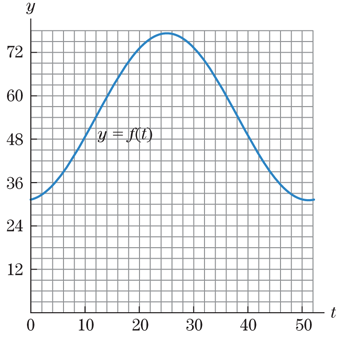
Concept explainers
(a)
The average weekly temperature at week


(b)
At week


(c)
The value of


(d)
The value of


(e)
The value of


(f)
The value of


Want to see the full answer?
Check out a sample textbook solution
Chapter 8 Solutions
CALCULUS+ITS APPLICATIONS
- For a person at rest, the velocity v (in liters per second) of airflow during a respiratory cycle (the time from the beginning of one breath to the beginning of the next) is modeled by v=0.85sint/3, where t is the time (in seconds). a Find the time for one full respiratory cycle. b Find the number of cycles per minute. c Sketch the graph of the velocity function. Use the graph to confirm your answer in part a by finding two times when new breaths begin. (Inhalation occurs when v0, and exhalation occurs when v0.)arrow_forwardRepeat the previous exercise to find the formula forthe APY of an account that compounds daily. Usethe results from this and the previous exercise todevelop a function I(n)for the APY of any accountthat compounds n times per year.arrow_forwardUse your schools library, the Internet, or some other reference source to find real-life applications of approximations of functions.arrow_forward
- A forest fire leaves behind an area of grass burned in an expanding circular pattern. If the radius of the circle of burning grass is increasing with time according to the formula r(t)=2t+1 , express the area burned as a function of time, t (minutes).arrow_forwardSales The projected monthly sales S (in thousands of units) of lawn mowers are modeled by S=74+3t40cost6 where t is the time (in months), with t=1 corresponding to January. (a) Graph the sales function over 1 year. (b) What are the projected sales for June ?arrow_forward
- Algebra & Trigonometry with Analytic GeometryAlgebraISBN:9781133382119Author:SwokowskiPublisher:Cengage
 Big Ideas Math A Bridge To Success Algebra 1: Stu...AlgebraISBN:9781680331141Author:HOUGHTON MIFFLIN HARCOURTPublisher:Houghton Mifflin Harcourt
Big Ideas Math A Bridge To Success Algebra 1: Stu...AlgebraISBN:9781680331141Author:HOUGHTON MIFFLIN HARCOURTPublisher:Houghton Mifflin Harcourt Trigonometry (MindTap Course List)TrigonometryISBN:9781337278461Author:Ron LarsonPublisher:Cengage Learning
Trigonometry (MindTap Course List)TrigonometryISBN:9781337278461Author:Ron LarsonPublisher:Cengage Learning 
 Functions and Change: A Modeling Approach to Coll...AlgebraISBN:9781337111348Author:Bruce Crauder, Benny Evans, Alan NoellPublisher:Cengage Learning
Functions and Change: A Modeling Approach to Coll...AlgebraISBN:9781337111348Author:Bruce Crauder, Benny Evans, Alan NoellPublisher:Cengage Learning Elementary Linear Algebra (MindTap Course List)AlgebraISBN:9781305658004Author:Ron LarsonPublisher:Cengage Learning
Elementary Linear Algebra (MindTap Course List)AlgebraISBN:9781305658004Author:Ron LarsonPublisher:Cengage Learning





